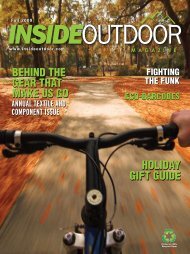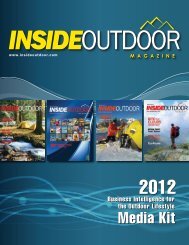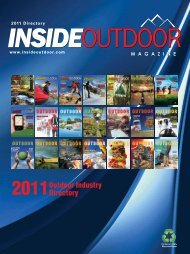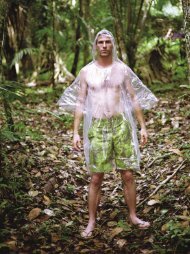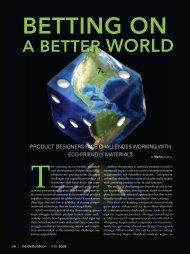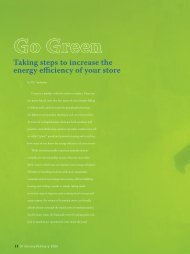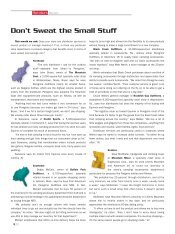Fall - InsideOutdoor Magazine
Fall - InsideOutdoor Magazine
Fall - InsideOutdoor Magazine
You also want an ePaper? Increase the reach of your titles
YUMPU automatically turns print PDFs into web optimized ePapers that Google loves.
Likewise, Primaloft continues to emphasize its<br />
Eco Yarn blend of 50 percent virgin Primaloft and 50<br />
percent recycled fibers made from plastic bottles.<br />
Continuing in the performance synthetics category,<br />
Invista also made some noise with the introduction<br />
of its COOLMAX EcoTech for legwear, which delivers<br />
the same high-performance, quick-dry benefits and<br />
comfort level as the current COOLMAX fabric with the<br />
added boost of being made from recycled resources,<br />
namely post-consumer PET bottles. In development<br />
since May 2007, EcoTech fiber will be available in two<br />
levels: Everyday and Extreme Performance.<br />
Tests for absorbency, wicking, hand, durability<br />
and abrasion resistance showed COOLMAX EcoTech<br />
fibers to be equivalent to existing COOLMAX fabric<br />
standards. EcoTech fibers also demonstrated superior<br />
results over current COOLMAX when tested for<br />
whiteness and piling, say Invista sources.<br />
Performance sock companies DeFeet and Injinji are<br />
among the earliest adopters to incorporate EcoTech<br />
into their lines.<br />
Elsewhere, Nüwa Textiles made its initial splash<br />
at the OR show and is hoping the ripples grow into<br />
a massive wave. For Nuwa, keeping plastic bottles<br />
out of landfills and building the market for recycled<br />
materials is just the beginning. Ultimately, the weaver<br />
wants textile executives to reconsider their entire<br />
production processes.<br />
“We look to deliver design innovation and a strong<br />
commitment to the environment that is unmatched<br />
in textile manufacturing,” said company president<br />
Michael Shih.<br />
To that end, the company’s facilities employ<br />
advanced energy production, efficient energy use,<br />
water-conserving dyeing machinery, emissions<br />
recycling and effluent treatment, while at the same<br />
time delivering eco-friendly fabrics to manufacturers<br />
worldwide. The weaving mills, which produce more<br />
than 20 million yards of fabric each month, are ISO<br />
9001, 14001 and 18001 certified, while Nüwa’s dyeing<br />
and finishing plant is Oeko-Tex certified and is in the<br />
process of certification by bluesign. In fact, a bluesign<br />
staff member informed the company that the 101<br />
liters of water per kilo of fabric it dyed was far below<br />
the 150 liters used by companies employing industry<br />
best practices.<br />
“We are continually changing<br />
our machines and refining our<br />
processes, filtering our waste<br />
and rethinking our transport,”<br />
says Shih.<br />
“We are continually changing our machines<br />
and refining our processes, filtering our waste and<br />
rethinking our transport,” says Shih.<br />
What’s more, the company insists that all of the<br />
factories in its supply chain recycle and reduce their<br />
water usage, control their air emissions and implement<br />
fair labor practices, says Shih.<br />
Honmuye Enterprises, for example, a weaving<br />
company in the Nüwa alliance, recycles 70 percent<br />
of the water used by its machines, while alliance<br />
member Sunny Dyeing and Finishing, owned by Shih’s<br />
father, eliminates open air emissions through a new<br />
coal gasification system and recycles water in its own<br />
water-treatment plant.<br />
“We are simply putting one foot in front of the<br />
other, to create a future where pollution and waste<br />
do not dominate, where chemistry is benign and<br />
transparency in business is a given,” says Shih.<br />
A similar philosophy is at work at German/<br />
Chinese leather producer ISA Tan Tec. While much<br />
still must be done to reduce the impact of effluents<br />
discharged from tanneries, ISA Tan Tec is taking<br />
steps in the right direction with news that ground<br />
has been broken on a new “ecologically friendly<br />
model factory” in Saigon, Vietnam. For starters, the<br />
plant will emit 35 percent less CO2 than conventional<br />
production facilities.<br />
“The demand from clients such as Timberland,<br />
New Balance, Keen, and Hush Puppies for<br />
ecologically friendly leather is increasing rapidly,”<br />
said Thomas Schneider, ISA Tan Tec founder and<br />
CEO. “That’s why, in addition to our new ecological<br />
factory in China, we’re building a second factory<br />
where our environmental concept will be even more<br />
thoroughly implemented.”<br />
Within the new facility, the hot water needed for<br />
the tanning process will be heated via solar modules,<br />
which also serve as roofing for the company parking<br />
lot, while ground water is pumped out by windmills.<br />
ISA Tan Tec also makes use of excess heat generated<br />
during production. The water heated while cooling<br />
hydraulic machinery, for instance, is channeled into<br />
the hot water tank. In addition, the company saves<br />
energy by using state-of-the-art tanning drums and<br />
infinitely variable air compressors. For its waste water<br />
treatment, ISA Tan Tec employs solid-liquid separation<br />
and continual waste water recycling to reduce the<br />
quantity of waste water treated, further decreasing<br />
energy consumption.<br />
“This is the only factory in the industry of this<br />
size that is pursuing such an ambitious environmental<br />
plan,” said Schneider.<br />
The new tannery will start operations in June<br />
of 2009 with 280 employees expected to produce 2<br />
million square meters of leather each year.<br />
42 | <strong>InsideOutdoor</strong> | <strong>Fall</strong> 2008



